

Antigone
Portage High School Auditorium
Portage High School
Portage, WI
Apr. 2008
Scenic and Lighting Design
by Patrick M. Strain
Costume Design by Judy Kruger
Music Direction
by Tom Shaver
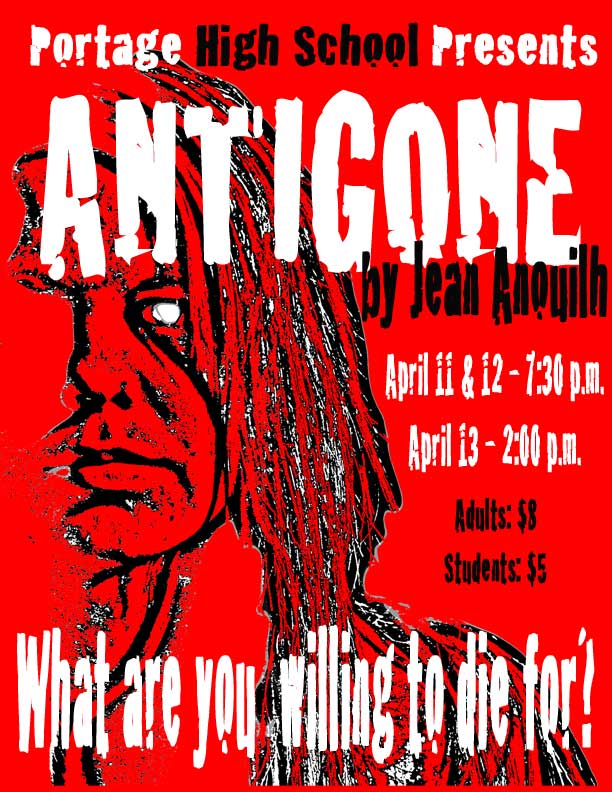
Poster design by Patrick Strain.
Production Photos:
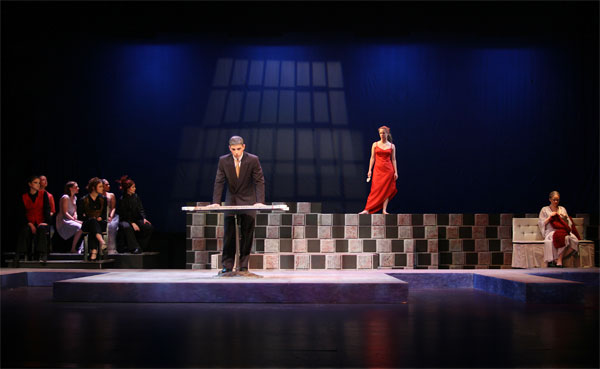
The chorus stayed on stage (left), as did the Queen (right).
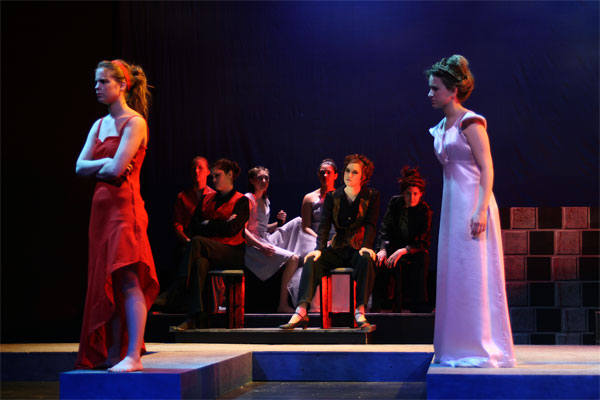
Isthmian (right) tells Antigone why she can't help - her fear of the Mob - while the Chorus watches on.
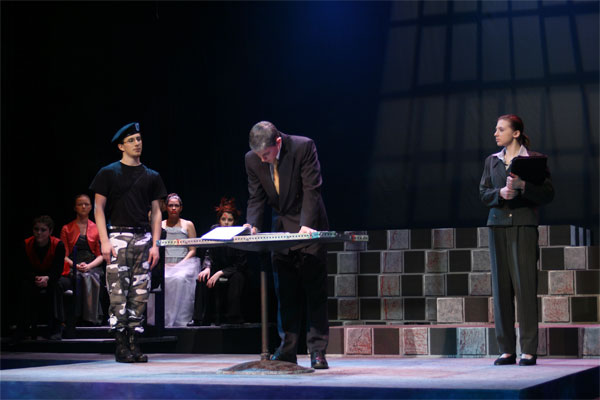
Creon, the neat politician, waits to finish his paperwork before he talks with Jonas.
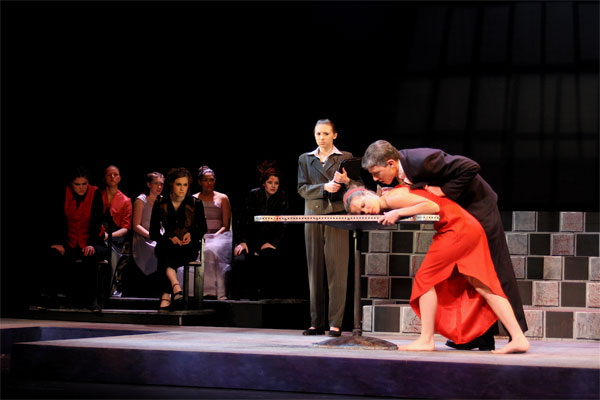
Antigone succeeds in getting Antigone to loose his cool, before he realizes his Page and the Chorus are looking.
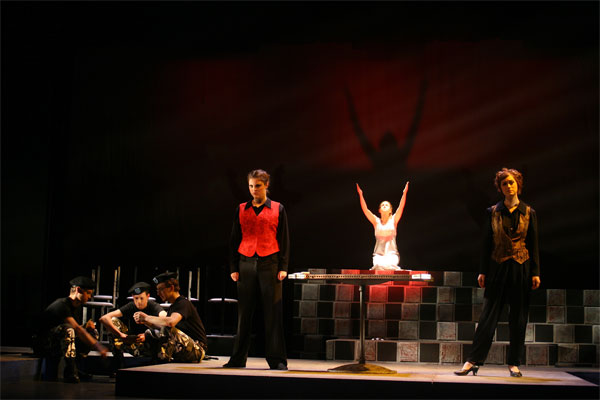
Isthmian resumes the burial ritual after Antigone is dead, (this is the same image Antigone created earlier in the show) as the Chorus concludes the show.
Production Notes: This is the first play I directed for the Portage High School. It wasn't supposed to be. I planned to direct Our Town. The problem was, I didn't get enough boys to audition. So I had to quickly change course, and had to find something that I could cast from my existing auditionee pool. I decided I needed to do something I was familiar with so I could change direction quickly. That show ended up being Antigone (Anouilh's translation being, to me, one of the most fluid and accessible.) I had designed the show when I was a teacher at West High School in Iowa City, IA, and the director of that show, Kate Hamm, did nice things with the show, so I am indebted to her work as my starting point. This is also why I don't have research images for this show - I moved quickly into the show, I had worked it before and many images I would use played out in the run up to the Presidential election.
In 2008, the Iraq war was a hot topic for the Presidential candidates. John McCain was the presumptive nominee and Hillary Clinton had not too long before aired her infamous "3 AM" ad. Politics were hot ground. War and violence hung in the air. The trustworthiness of politicians was (and perhaps always is) in question. And so, it seems, the stars aligned for a powerful production about politics. Also, I firmly believe educational theatre has a duty to present plays that in some way represent the history of theatre.
The design concept was not overly complex. In a nod to Greek theatre, I wanted to keep it simple. I had been planning to do Our Town, so I hadn't planned a guest scene designer, so I wanted to keep it simple for that reason, as well. A bit of platforming and steps painted with an optical illusion set of alternating black and white squares kept the linear world shifting. A background cyc with a scrim pulled to an angle gave us a nice background for broad strokes of color and texture. At the top center of the stage, was a platform that evoked the burial site - used only when Antigone (and in the closing moments, Isthmian) perform the rites. There was a box-like area, ala a jury, for the Chorus, and a "dead end" at the opposite end for the Queen to sit and knit. There was a central platform area for an altarish table and two "catwalks" on either side that allowed characters to isolate themselves or be trapped by another.
So...I used a modern context. This play, and this production, really reflect how I approach theatre. Keep it simple. Keep it honest. Don't try to interfere too much. My Midsummer Night's Dream is about as "conceptual" as I've gotten. So, a clean tragedy is right up my alley. Creon, the king, evoked Presidential strength and cool. With eight years of "W," with his self-assured, if not self-righteous air, almost behind and the Presidential choices being the "hot-head" McCain and "too cool" Obama, my actor had a lot of options to choose from. And this was one lesson I had learned from working on a previous production of this show with HS students - it was essential to keep Creon from turning into a screaming maniac. And my Creon found his cool. He knew he was in charge now and that the power of the estate was at his disposal, and that displays of anger were really a weakness.
In Antigone, I felt the essence was her sensuality. Not sexuality. She is a woman who loves the sensual experiences of being alive - walking in the cool, wet morning grass - savoring a morning coffee - and yes, a slow kiss. She is a free spirit and moved like a light breeze across the stage. And if she could get Creon to lose his cool, she would win the day. A simple, though effective way to keep the play interesting.
In the Chorus, I took the memory of what Kate had done in creating a trio of the Chorus, and expanded that into a sextet. Partly for reasons of casting - to use the talented kids I had - and partly to reflect the splintered nature our American political system has become. There were two members of the Chorus who were, essentially, campaign managers for either Creon or Antigone - supporting their respective leader. The remaining four split along characteristic lines - the Innocent, the Feminine, the Warrior, the Royal. The result was a Chorus that spoke TO each other as well as to us. Asked questions as well as provided answers. This split also allowed me to physicalize their support (sometimes sympathetic to Creon, sometimes to Antigone) and create stage pictures that reinforced their splintered and wavering will.
The last bit I want to discuss is the table. It became for us an altar. The location at which things were sacrificed. Creon (at least in his mind) sacrificed his life there in work to the state. Antigone used it as she sacrificed her love, Haemon. Creon lays Antigone across it (see above photo) when he has finally decided he must sacrifice her.